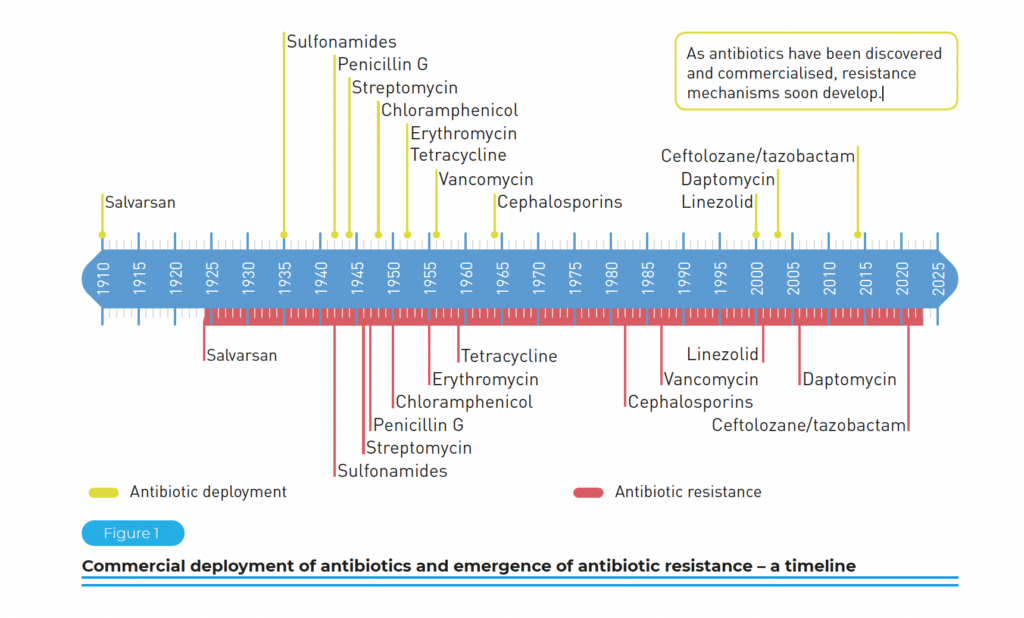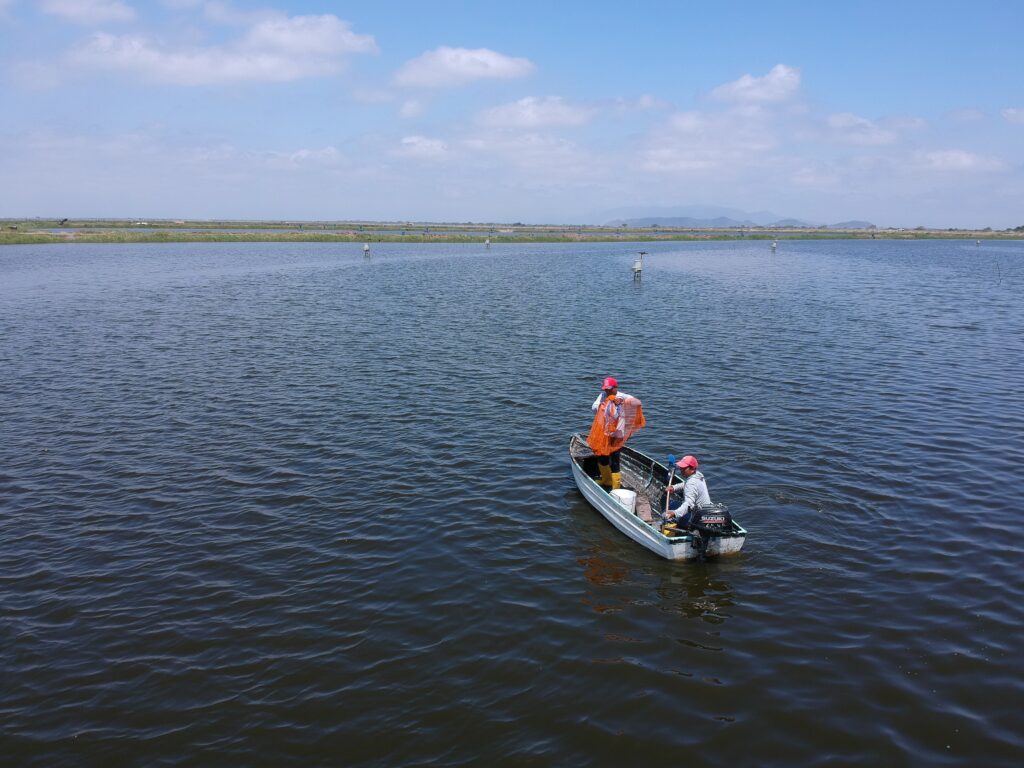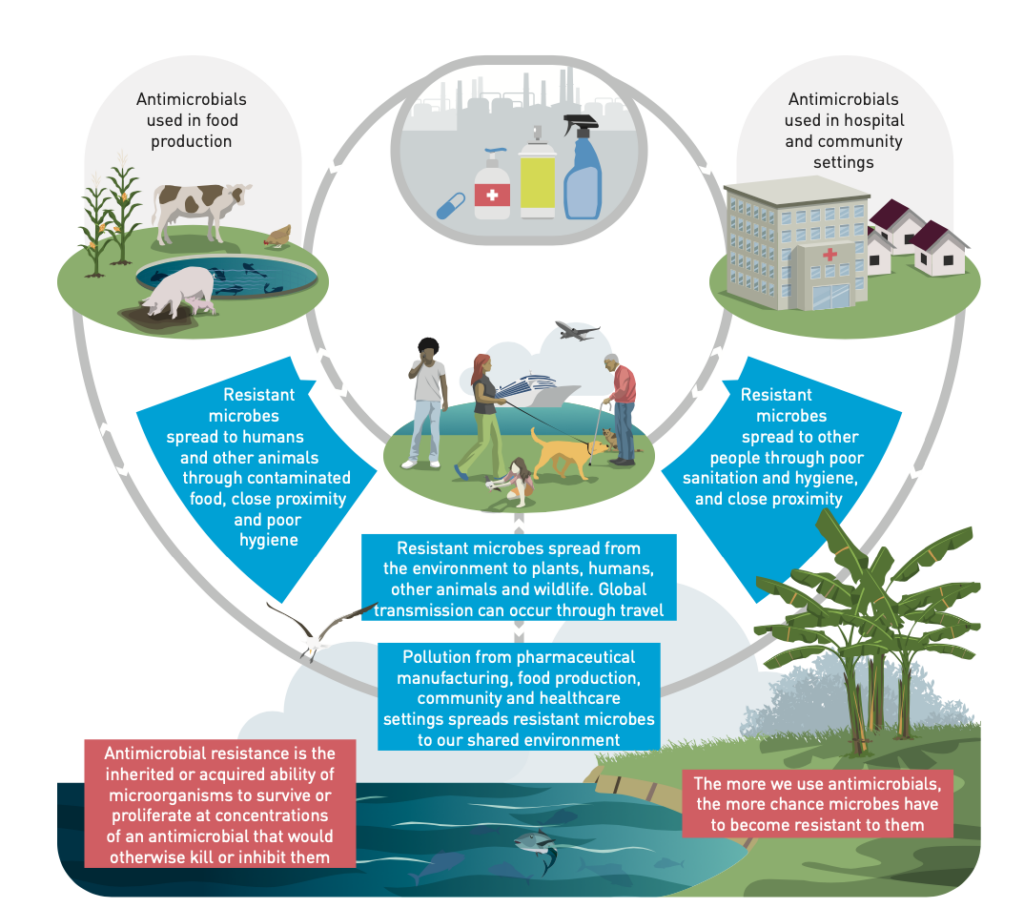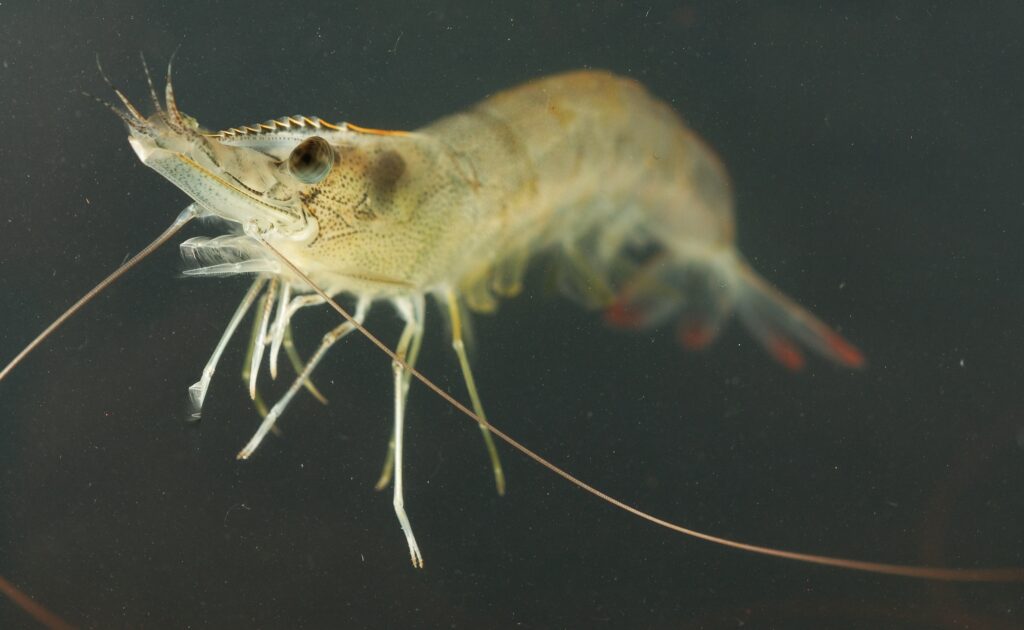Antimicrobial Resistance: A Global Challenge Calling for Local Solutions
AMR poses a critical risk to human health, animal welfare, and environmental equilibrium. Addressing this crisis is crucial to ensure a healthy and sustainable future for everyone.
Pamela Nath and Sally Tabares
Featuring:
Felipe Cabello, Professor in the Department of Pathology, Microbiology, and Immunology at New York Medical College.
Arturo Quizhpe, Director of ReAct Latin America.
November 18, 2023
In an increasingly interconnected world, antimicrobial resistance has become a concern that crosses borders. Antimicrobials, which were once our first line of defense against bacterial infections, are becoming less effective due to their excessive and irresponsible use. This phenomenon impacts all inhabitants of the planet: the balance of ecosystems, human health, and that of animals, including shrimp.
Antimicrobial resistance is not a problem that we should leave exclusively in the hands of scientists or authorities. It is a challenge that involves everyone. As a shrimp aquaculture industry, we have several local solutions that can make a difference.
However, the solution is not limited to reducing the use of antimicrobials. It also involves raising awareness about the importance of these medications for public health, promoting and adopting responsible management practices, enhancing biosecurity measures, and much more.
Our responsibility to the planet and future generations demands that we assume a proactive role in seeking new solutions. Instead of viewing antimicrobial resistance as an overwhelming threat, we can transform it into a turning point for our sector.
Over the years, our industry has demonstrated a clear ability for adaptation and innovation. For this reason, antimicrobial resistance can be viewed as an opportunity to strengthen our commitment to sustainability and to once again showcase our resilience and creativity.
The comprehensive strategy to address antimicrobial resistance involves collaboration across sectors, promoting good practices, reducing unnecessary antimicrobial use, and public education. We must act locally while thinking globally. Together, we can preserve the health of our consumers and products, protect the biodiversity of our environment, and ensure a sustainable future for our industry and the future of our planet.

Pamela Nath
Director of Sustainable Shrimp Partnership
In an increasingly interconnected world, antimicrobial resistance has become a concern that crosses borders. Antimicrobials, which were once our first line of defense against bacterial infections, are becoming less effective due to their excessive and irresponsible use. This phenomenon impacts all inhabitants of the planet: the balance of ecosystems, human health, and that of animals, including shrimp.
Antimicrobial resistance is not a problem that we should leave exclusively in the hands of scientists or authorities. It is a challenge that involves everyone. As a shrimp aquaculture industry, we have several local solutions that can make a difference.
However, the solution is not limited to reducing the use of antimicrobials. It also involves raising awareness about the importance of these medications for public health, promoting and adopting responsible management practices, enhancing biosecurity measures, and much more.
Our responsibility to the planet and future generations demands that we assume a proactive role in seeking new solutions. Instead of viewing antimicrobial resistance as an overwhelming threat, we can transform it into a turning point for our sector.
Over the years, our industry has demonstrated a clear ability for adaptation and innovation. For this reason, antimicrobial resistance can be viewed as an opportunity to strengthen our commitment to sustainability and to once again showcase our resilience and creativity.
The comprehensive strategy to address antimicrobial resistance involves collaboration across sectors, promoting good practices, reducing unnecessary antimicrobial use, and public education. We must act locally while thinking globally. Together, we can preserve the health of our consumers and products, protect the biodiversity of our environment, and ensure a sustainable future for our industry and the future of our planet.

Pamela Nath
Director of Sustainable Shrimp Partnership
Almost 95 years ago, Alexander Fleming discovered that substances produced by certain fungi had the effect of destroying microbial cultures, giving rise to the first naturally sourced antibiotic. Initially, its primary purpose was to combat infectious diseases in humans. However, over time, its use expanded beyond initial expectations, being employed extensively and generically, not only in human medicine but also in other fields, including animal production.
Since the Green Revolution around 1960, animal-origin food production industries experienced a shift in their production practices. What used to be an extensive industry transformed into an extremely intensive one, with a significant increase in the concentration of animals, both in physical terms and in quantity.
With the intensification of this sector, the use of antimicrobials in animal farming became a common strategy to promote growth, prevent, and cure diseases in these organisms. However, as time passed, new antibiotics were developed, and subsequently, the side effects of this practice began to manifest, leading to a significant problem: antimicrobial resistance (AMR).

Source: Bracing for Superbugs Strengthening environmental action in the One Health response to antimicrobial resistance (FAO).
Currently, the World Health Organization (WHO) has identified antimicrobial resistance (AMR) as one of the top ten global threats to public health. Antimicrobial resistance is a natural and inevitable process that has significantly accelerated due to human activities, such as self-medication with antimicrobial compounds without prescriptions from specialized professionals, lack of awareness regarding antimicrobial effects, and their use and abuse for prophylactic purposes in both human and veterinary medicine.
In this context, aquaculture represents a significant concern regarding the risk of antimicrobial resistance spread due to its tendency for these to emerge, persist, and propagate in the aquatic environment. This environment is already recognized as an important repository of clinically relevant antimicrobial resistance genes (Marti et al., 2014).
AMR ranks among the top 10 public health threats
By the year 2030, it is projected that food production from aquaculture will increase by 13% compared to 2022. An estimated 59% of the available aquatic food for human consumption will originate from aquaculture, according to information from the Food and Agriculture Organization (FAO) of the United Nations. As aquaculture stands as one of the fastest-growing sectors in the global food industry, it is essential to reflect on the role of the shrimp industry in combating antimicrobial resistance.
“Preserving bacteria’s susceptibility to antimicrobials is crucial because infections caused by bacteria resistant to these drugs tend to result in more complications, becoming a critical therapeutic challenge that could endanger the life of the affected organism,” states Felipe Cabello, a professor in the Department of Pathology, Microbiology, and Immunology at New York Medical College.
“Preserving bacteria’s susceptibility to antimicrobials is crucial because infections caused by bacteria resistant to these drugs tend to result in more complications, becoming a critical therapeutic challenge that could endanger the life of the affected organism,” states Felipe Cabello, a professor in the Department of Pathology, Microbiology, and Immunology at New York Medical College.
Antimicrobials are substances designed to eliminate or stop the growth of microorganisms, such as bacteria, fungi, or parasites. These compounds include antibiotics, fungicides, and parasiticides. Therefore, antimicrobial resistance occurs when these microorganisms cease to respond to treatments to which they were previously sensitive.
“There is a concept known as the ‘antimicrobial paradox,’ which suggests that the more we use these medications, the more we help microorganisms in becoming resistant to them,” informs Cabello. “When we use antimicrobials, what happens is that we select and accelerate natural processes in the life of bacteria, as bacteria are constantly mutating and exchanging genetic information among themselves,” he points out.
Microorganisms can exhibit intrinsic antimicrobial resistance or acquire it later on. In the case of acquired resistance, it can arise through mutations or, in the case of bacteria, also through a mechanism known as horizontal gene transfer, where bacteria acquire DNA from different microorganisms (Levy & Marshall, 2004; Martínez, Coque, & Baquero, 2015).
“For many years, food industries employing antimicrobials claimed that their use had no negative repercussions on human or animal health, suggesting that it caused no harmful effects. However, in the last 15 years, it has been demonstrated that industrial animal farming contributes to the development and spread of antimicrobial resistance,” warns Cabello.
A FAO study titled “Use of Antimicrobials in Livestock: Impact on Development of Antimicrobial Resistance in Public Health” emphasizes that the development of resistance in bacteria from animals treated with antibiotics is the major health risk to consumers. These resistances can lead to therapeutic failures in veterinary treatments and increase the “risk of transferring resistant bacteria from animals to humans, or genes carrying information encoding resistance from animal bacteria to human bacteria.”
The report ‘Evaluating Antimicrobial Resistance in the Global Shrimp Industry,’ published in the journal ‘Reviews in Aquaculture,’ highlights various reasons why shrimp farms could be potential points for the spread of antimicrobial resistance. Among these reasons are extremely high population densities, resulting in a high density of associated bacteria, and elevated stress levels in the shrimp, making them more vulnerable to contracting infections.
“In industrial farming, antimicrobials are often used to prevent these infections. However, this isn’t the most suitable practice because, many times, infections are not prevented; rather, they are delayed, and later on, infections caused by antimicrobial-resistant bacteria appear, which are more challenging to treat. What should be done is to raise animals in hygienic conditions and optimal densities to reduce the likelihood of animals contracting infections,” explains Cabello.
Another reason mentioned by the authors of the report on antimicrobial resistance in the global shrimp industry includes widespread use of chemicals, discharge of untreated waste into the local environment, and high levels of unprotected human contact with water and animals.

“It is commonly believed that when antibiotics or other antimicrobials are used in water, such as in the sea, lakes, or rivers, they are diluted or carried away by currents, suggesting they have minimal impact on the environment. However, this is not entirely true because the quantities used are so large that often they do not dilute well and accumulate in sediments,” emphasizes Cabello.
“It is commonly believed that when antibiotics or other antimicrobials are used in water, such as in the sea, lakes, or rivers, they are diluted or carried away by currents, suggesting they have minimal impact on the environment. However, this is not entirely true because the quantities used are so large that often they do not dilute well and accumulate in sediments,” emphasizes Cabello.
The professor also highlights that some antimicrobials, such as chloramphenicol and quinolones, have very slow degradation, which implies that they can remain in the environment for a long period, extending even for months or years. This, in turn, can contribute to the prolonged selection of resistant bacteria.
Furthermore, in the previously mentioned report, the authors also point out that the shrimp industry can be a potential hotspot for the spread of antimicrobial resistance due to the large quantity of shrimp being transported and consumed both domestically and internationally (Thornber, Kelly et al., 2020).
Cabello indicates that antimicrobial-resistant bacteria can be present in the final product. “When humans consume these foods containing bacteria with antimicrobial resistance, in some cases, these bacteria can transmit that resistance to humans. This can affect both the bacteria residing in the normal human gut as well as pathogens such as salmonella and staphylococcus, among others,” he adds.

How antimicrobial resistance can spread (adapted from Australia, Department of Health and Aged Care 2017). Source: Bracing for Superbugs. Strengthening environmental action in the One Health response to antimicrobial resistance.
Arturo Quizhpe, director of ReAct Latin America, a global network dedicated to combating antibiotic resistance, highlights the serious threat that AMR represents to the advancements of modern medicine, particularly in the case of antibiotics. He emphasizes that without effective antibiotics, many of the current medical procedures would simply not be viable.
“Antibiotics constitute a public good as they are the foundation of modern medicine. If antimicrobial resistance continues to increase at the current pace, we face the possibility of being unable to treat infections that are now part of everyday treatment, such as pneumonia, kidney conditions, or skin infections. The number of patients not responding to this treatment is continually rising. In other words, antibiotics have significantly lost their effectiveness,” warns Quizhpe.
The book “Brock Biology of Microorganisms” reports that among commercially manufactured antimicrobial products, antibiotics are likely the most important due to their capacity to treat infectious diseases. Furthermore, it indicates that more than 8,000 antibiotic substances are known, and it can be confidently stated that there are still more antibiotics waiting to be discovered.
However, the development of new antibiotics does not represent a sustainable long-term solution to address the problem of antimicrobial resistance, as detailed by Quizhpe. “Antibiotics are special medications that lose effectiveness as they are used, making them less profitable. For this reason, the pharmaceutical industry has reduced production, research, and the development of new formulations. In other words, partially, the solution lies in creating and producing new antibiotics. But this measure doesn’t completely solve the problem, as a few years after discovering a new formulation, depending on the intensity of its use, antibiotics may become ineffective due to the resistance developed by bacteria,” he affirms.
The Sustainable Shrimp Partnership (SSP) shares this concern and acknowledges the close relationship between antibiotic use in animal food production and the emergence of antimicrobial resistance in humans. For this reason, this initiative considers it vital to protect consumer health by eliminating the use of antibiotics in shrimp production.
SSP member farms strictly prohibit the use of antibiotics in shrimp farming and undergo constant monitoring throughout each production cycle to ensure the quality and safety of the product intended for consumers.
“Antimicrobial resistance needs urgent attention, and at SSP, we are committed to not being part of the problem but rather part of the solution. Consumers’ health is at stake, and we are confident that we can raise standards and adopt more responsible and suitable practices in the global shrimp aquaculture industry,” states Pamela Nath, the director of SSP.
“SSP members stand as solid evidence that it is possible to produce high-quality shrimp without the use of antibiotics. We are demonstrating that a viable and sustainable alternative exists for shrimp production, benefiting both consumers and the industry,” she adds.
Dr. Leonardo Maridueña, Technical Coordinator at SSP, highlights that the most effective approach to managing diseases in shrimp cultivation is through prevention. This can be accomplished by implementing robust biosecurity practices. “By applying biosecurity principles, the likelihood of these diseases occurring is significantly reduced. For it to work properly, it’s essential to have discipline and provide training to the personnel working daily in shrimp management,” he details.
According to the study “Application of Biosecurity in Aquaculture Production Systems,” when it comes to safeguarding farmed shrimp, two crucial steps must be taken: preventing pathogens from entering and eliminating them if they are already present.
Some recommendations to exclude pathogens include:
1Physical measures: These are actions aimed at preventing disease-carrying organisms from entering the areas where shrimp are bred. This includes using physical barriers such as nets, properly treating water, and quarantining larvae and shrimp before placing them into the pools.
2Chemical Measures: This involves utilizing chemical products to clean and disinfect equipment before it comes into contact with the shrimp. Chlorine, UV radiation, and ozone are used to purify the water, while iodine and chlorine are employed to clean tools and implements.
3Biological Measures: Prebiotics and probiotics can be employed to neutralize or eliminate pathogenic bacteria existing in the environment. These are commercially available options that contribute to this process.
4It’s also important to exercise caution regarding the importation of live and frozen shrimp to prevent the introduction of diseases from other locations.
5Implementing biosecurity measures is crucial to prevent the introduction of contamination from outside the farm.
Some recommendations for eliminating present pathogens include:
If a disease occurs in a particular pond, effective biosecurity measures should prevent the complete loss of the harvest and the spread of the disease to other ponds or aquaculture farms.
1To eliminate pathogens in the affected ponds, the affected organisms should be removed and incinerated. Production water should be treated with chlorine before discharge, and the pond bottoms should be disinfected with calcium carbonate. Exposing them to sunlight helps eradicate any remaining traces of the disease (the disinfection period varies depending on the severity of the case).
2It’s also recommended to improve environmental and biological conditions to prevent disease proliferation. This includes:
Physical Measures: Enhancing aeration and optimizing the feeding regimen.
Chemical Measures: Controlling pH levels and reducing nitrogen and phosphorus.
Biological Measures: Utilizing probiotics containing a blend of bacterial species to establish beneficial microbial communities in cultivation conditions.

Dr. Cabello reports an encouraging and optimistic perspective drawn from the experiences of countries like Denmark, the Netherlands, and Germany. These nations have demonstrated that limiting the use of antimicrobials in industrial animal farming can lead to a decrease in antimicrobial resistance in both animals and humans.
“Many people believe that antimicrobial resistance will persist or that with restrictions on antimicrobial use, it will be economically impossible to sustain food production industries. However, that has not been the case. These countries have demonstrated that it is something that can be done, that restricting antimicrobial use is viable, and that industries have not suffered economically. This is a positive point to remember,” expresses Cabello.
A global reduction of 13% in the use of antimicrobials in animals has been observed over a period of three years, as claimed by the Annual Report on Antimicrobial Agents Intended for Use in Animals released by the World Organisation for Animal Health (OIE).
The fight against antimicrobial resistance is a commitment that demands coordinated actions across all levels of society. The experience of the previously mentioned countries and shrimp-producing farms, members of SSP, demonstrates that there are viable solutions. The collective effort can lead to a future where antimicrobial resistance is managed, ensuring better protection for everyone’s health.
